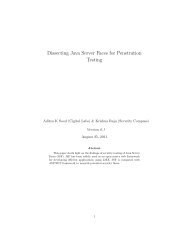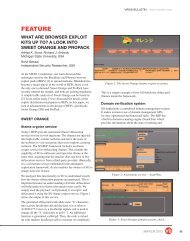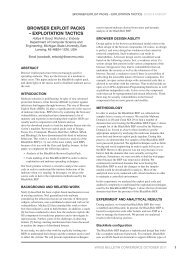Spying on the browser: dissecting the design of malicious extensions
Spying on the browser: dissecting the design of malicious extensions
Spying on the browser: dissecting the design of malicious extensions
You also want an ePaper? Increase the reach of your titles
YUMPU automatically turns print PDFs into web optimized ePapers that Google loves.
FEATURE<br />
Data transfer<br />
mechanism<br />
Once informati<strong>on</strong> is stolen, an asynchr<strong>on</strong>ous<br />
XML-based HTTP request,<br />
XMLHttpRequest, is used to transfer <strong>the</strong><br />
stolen data back to <strong>the</strong> attacker’s server.<br />
In Listing 3, <strong>the</strong> functi<strong>on</strong> sends all <strong>the</strong><br />
captured key strokes to <strong>the</strong> attackerc<strong>on</strong>trolled<br />
domain. These key strokes<br />
are nothing but data entered in <strong>the</strong><br />
forms during an active sessi<strong>on</strong> when <strong>the</strong><br />
<strong>browser</strong> is interacting with banking websites.<br />
The data is captured character by<br />
character and transferred to <strong>the</strong> attacker’s<br />
server running PHP-based log management<br />
scripts.<br />
“In general, it is hard to <strong>design</strong><br />
dynamic soluti<strong>on</strong>s to prevent<br />
<strong>the</strong> executi<strong>on</strong> <strong>of</strong> <strong>malicious</strong><br />
extensi<strong>on</strong>s. A user has to be<br />
aware <strong>of</strong> <strong>the</strong> types <strong>of</strong> extensi<strong>on</strong>s<br />
running in <strong>the</strong> <strong>browser</strong> and<br />
<strong>the</strong>ir functi<strong>on</strong>s. Unauthorised<br />
extensi<strong>on</strong>s (unverified) should<br />
not be allowed to install in <strong>the</strong><br />
<strong>browser</strong>”<br />
PHP-based back-end<br />
server log module<br />
Malicious extensi<strong>on</strong>s communicate with<br />
<strong>the</strong> back-end servers to store stolen informati<strong>on</strong><br />
<strong>of</strong>fsite. The attacker’s back-end<br />
server remains in a listening state in order<br />
to store informati<strong>on</strong> from <strong>the</strong> infected clients.<br />
Usually, a PHP-based script is used,<br />
as presented in Listing 4, to complete logging<br />
operati<strong>on</strong>s. The attacker uploads <strong>the</strong><br />
PHP file <strong>on</strong> <strong>the</strong> domain to open a communicati<strong>on</strong><br />
channel between <strong>the</strong> infected<br />
<strong>browser</strong> and <strong>the</strong> server.<br />
The <strong>the</strong>ft<br />
The data collected from <strong>the</strong> <strong>browser</strong> and<br />
<strong>the</strong>n passed to <strong>the</strong> attacker’s back-end<br />
server can be from a variety <strong>of</strong> sources,<br />
but <strong>on</strong>e <strong>of</strong> <strong>the</strong> most useful is <strong>the</strong> login<br />
and password used for banking. With<br />
that informati<strong>on</strong> in hand, an attacker<br />
can clean out a bank account. If this<br />
attack is performed <strong>on</strong> an individual it<br />
can yield thousands <strong>of</strong> dollars, but if <strong>the</strong><br />
attack is performed <strong>on</strong> a small business<br />
it can yield tens or hundreds <strong>of</strong> thousands<br />
<strong>of</strong> dollars.<br />
The steps discussed above illustrate<br />
<strong>on</strong>e instance <strong>of</strong> extensi<strong>on</strong>-based malware<br />
that is used to spy <strong>on</strong> <strong>browser</strong>s. The case<br />
study discussed above is an outcome <strong>of</strong> an<br />
analysis <strong>of</strong> a <strong>malicious</strong> extensi<strong>on</strong> that is<br />
<strong>design</strong>ed to steal passwords from <strong>the</strong> login<br />
forms from various <strong>browser</strong>s. Extensi<strong>on</strong>based<br />
malware has a potential impact <strong>on</strong><br />
<strong>the</strong> robustness <strong>of</strong> <strong>browser</strong>s. In general,<br />
it is hard to <strong>design</strong> dynamic soluti<strong>on</strong>s to<br />
prevent <strong>the</strong> executi<strong>on</strong> <strong>of</strong> <strong>malicious</strong> extensi<strong>on</strong>s.<br />
A user has to be aware <strong>of</strong> <strong>the</strong> types<br />
<strong>of</strong> extensi<strong>on</strong>s running in <strong>the</strong> <strong>browser</strong> and<br />
<strong>the</strong>ir functi<strong>on</strong>s. Unauthorised extensi<strong>on</strong>s<br />
(unverified) should not be allowed to<br />
install in <strong>the</strong> <strong>browser</strong>.<br />
C<strong>on</strong>clusi<strong>on</strong><br />
Extensi<strong>on</strong>s provide flexibility and portability<br />
in <strong>browser</strong>s. However, this case study<br />
shows an exploitati<strong>on</strong> <strong>of</strong> <strong>the</strong> default <strong>design</strong><br />
<strong>of</strong> <strong>the</strong> <strong>browser</strong> extensi<strong>on</strong> model which<br />
poses a serious threat to users. Attackers<br />
write sophisticated malware to try to<br />
exploit <strong>the</strong> inherent <strong>design</strong> <strong>of</strong> <strong>browser</strong>s.<br />
The analysis above shows that extensi<strong>on</strong>based<br />
malware is very hard to detect and it<br />
can interact with <strong>the</strong> operating system with<br />
full privileged rights. This poses a grave<br />
risk to <strong>the</strong> privacy and security <strong>of</strong> users.<br />
About <strong>the</strong> authors<br />
Aditya K Sood is a security researcher, c<strong>on</strong>sultant<br />
and PhD candidate at Michigan<br />
State University. He has worked in <strong>the</strong><br />
security domain for Armorize, COSEINC,<br />
and KPMG and founded SecNiche<br />
Security. He has been an active speaker at<br />
c<strong>on</strong>ferences such as RSA, Toorc<strong>on</strong>, Hacker<br />
Halted, TRISC, EuSecwest, XCON,<br />
OWASP AppSec, CERT-IN and has<br />
written c<strong>on</strong>tent for HITB Ezine, ISSA,<br />
ISACA, Elsevier, Hakin9 and Usenix<br />
Login. He may be reached at adi_ks@<br />
secniche.org.<br />
Dr Richard Enbody is an Associate<br />
Pr<strong>of</strong>essor in <strong>the</strong> Department <strong>of</strong> Computer<br />
Science and Engineering, Michigan State<br />
University. He joined <strong>the</strong> faculty in 1987<br />
after earning his PhD in Computer Science<br />
from <strong>the</strong> University <strong>of</strong> Minnesota. His<br />
research interests are in computer security,<br />
computer architecture, web-based distance<br />
educati<strong>on</strong> and parallel processing. He has<br />
two patents pending <strong>on</strong> hardware bufferoverflow<br />
protecti<strong>on</strong>, which will prevent most<br />
computer worms and viruses. He recently coauthored<br />
a CS1 Pyth<strong>on</strong> book, The Practice<br />
<strong>of</strong> Computing using Pyth<strong>on</strong>. He may be<br />
reached at enbody@cse.msu.edu.<br />
Resources<br />
• Ter Louw, M; Lim, JS; Venkatakrishnan,<br />
VN. ‘Enhancing web <strong>browser</strong> security<br />
against malware extensi<strong>on</strong>s’. .<br />
• Florio, Elia; Wüest, Candid. ‘Firefox<br />
and Malware: when your <strong>browser</strong><br />
bites you’. .<br />
References<br />
1. Keizer,G. ‘Mozilla yanks password-stealing<br />
Firefox add-<strong>on</strong>’.<br />
Computerworld, 14 Jul 2010.<br />
Accessed Apr 2011. .<br />
2. ‘Mozilla Add-<strong>on</strong> Extensi<strong>on</strong> Steals<br />
Login Details’. Spamfighter, 27 Jul<br />
2010. Accessed Apr 2011. .<br />
3. Elliot, Kevin; Binkley, Jim; Hook,<br />
James. ‘Mozilla Firefox Extensi<strong>on</strong><br />
Security: an overview <strong>of</strong> potential<br />
attack vectors’. 2 Dec 2009. Accessed<br />
Apr 2011. .<br />
4. Felt, AP. ‘A Survey <strong>of</strong> Firefox<br />
Extensi<strong>on</strong> API Use’. 16 Oct 2009.<br />
Accessed Apr 2011. .<br />
5. Barth, A; Felt, AP; Saxena, P;<br />
Boodman, A. 2009. ‘Protecting<br />
Browsers from Extensi<strong>on</strong><br />
Vulnerabilities’. 2009. .<br />
12 Network Security May 2011












